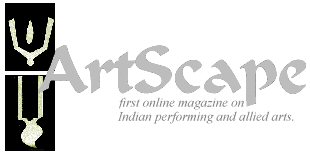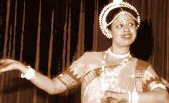ARTICLES
www.artindia.net
does not take any responsibility whatsoever
with regard to articles/ reviews/ previews /information published here.
Any suggestions/ comments /complaints etc. may be sent directly to the
writers/ contributors directly. We invite
you to contribute articles/ reviews etc. to ArtScape. You may sent in
your stories to art.india@yahoo.com along with scanned pictures.

 Suprava
Mishra is an exponent of Odissi. Founder of Aum Dance Academy, Suprava is
also an official of the Department of Telecommunications, Government of
India. She has performed widely in India and abroad and has received several
awards and recognation
Suprava
Mishra is an exponent of Odissi. Founder of Aum Dance Academy, Suprava is
also an official of the Department of Telecommunications, Government of
India. She has performed widely in India and abroad and has received several
awards and recognationBy Suprava Mishra
Dance is the form of vibration of our body and mind. It is a form of worship through which a dancer can reach the Almighty. It is a form of Yoga. A dancer can only reach this stage through the continuous training i.e. 'Sadhana'. So in my view the child who will learn dance, the first thing she has to undergo a hard training from which she will learn discipline and patience which are the most important factors in a child's life.
The second thing is the total body movement of a dancer so that a child has Her complete physical fitness and got the control over body. The third thing dance is a mode of expression of our inner feelings. So she can express herself through dance. In that way she will develop self belief and self confidence. The fourth thing Indian Classical Dance is based on mythology & puranas. So when a child learn dance she is bound to know the story of Mahabharata, Ramayana, Bhagbat Geeta, Shiv Purana, immortal books of Mahakavi Kalidas etc. So in this way she can also learn the great Indian Literature. So after all her knowledge will be enhanced. Fifth thing when a child will learn Indian classical dance automatically she will come to know about the rich cultural heritage of India.
We speak of culture as simplifying an all round development of human faculties. It has been said that science is curiosity about life, art is wonder at life, philosophy is an attitude towards life and religion is reverence for life. True culture includes all these four aspects and a cultured man ought to show development along all these four lines. It is therefore, obvious that education in aesthetics is as essential as if not more than mere intellectual or physical education. Man can never be complete or balanced or harmonical unless his emotions are trained, developed and sublimated, and here comes in the need for introducing art in our educational curriculum as a compulsory subject. Classical Dance is the highest form of art.
The true object of education is to develop human personality in all its aspects. Any over emphasis on a particular aspect to the neglect of another may lead to a kind of lop-sided development which in the long run may do more harm than good. There was a time in our educational history when emphasis was laid only upon the intellectual development of the student. In those days there was very little attention paid even to physical development. Latter they began to consider the importance of physical instruction so much so that one's proficiency in sports was given great weight in selecting candidates for certain appointments. But man is not merely his intellect and his physical body. He is much more. He has his emotions which play a more vital part in his development and the development of his nation than is ordinarily recognized.
Unfortunately the development of human emotions has not received that attention which is due to it in our educational institutions. In one sense it may be said that the present dead lock in world affairs is due to a large extent due to the lop-sided development of human personality referred to above. All emphasis was laid on head development while the heart of humanity was allowed to starve. It is this over-development of the head at the expense of the heart that has gone a long way to supply the psychological basis for our modern troubles. If there had been a balanced progress of the head and heart, human nature would have developed certain fundamental moral values which would have mad it impossible for the present world muddle to have come about. It is therefore, necessary that the heart development of the pupil should receive great attention at the hands of the educationalists. A great Chinese proverb says, " If you have two loaves, sell one and buy a lily". The implication is obvious. Do not concentrate your attention on only food and drink, but pay equal attention to the development of your aesthetic nature.
The greatness or littleness of the nation in the future is to a very large extent, dependent on how the youth of today are trained. In the first place, they have to become cultured citizens, they must help our nations to express the best in her along her own lines and consistently with her special genius. The second idea at the back of an educational system properly organized must be to help the citizen to express himself as a unit of the nation to which he belongs. Each nation has a soul of its own which tries to express itself in several modes of thought and activity, and we are all, in one sense, only cells in that bigger organism. The standard culture of an eastern nation differs, in several essential points, from that of a western nation. And so in Art there is a great national art peculiar to India. There are some special features about Indian Classical dance which distinguish it from other dance of the World. And if our youths are to be trained to be channels for the expression of our national consciousness the training of dance we impart to them must be truly national, truly Indian in spirit. There is nothing to prevent an Indian from admiring or learning foreign dance, but then she must already have learnt Indian dance.
An Indian who does not care for the dance of his country cannot really understand any foreign dance, though he might be able to indulge in spurious imitation. We should also see that its retains its distinctive feature and that, if any change is made at all, such change must be organic, not sudden, and it must be an evolution in accordance with the heart of the national genius. And so I plead that while dance should form part of our school curriculum it should be essentially Indian for Indian students.
© Art India Net. ® 1998--2007. We welcome your suggestions and comments to improve this site. Please post an e-mail to add information.
Founder/ Content Editor/ Site Construction/ Maintenance: GS Rajan, Technical Advisor: Sudhir Gandotra Hosted by Communicators - Indserve Infotech P Ltd. © ®